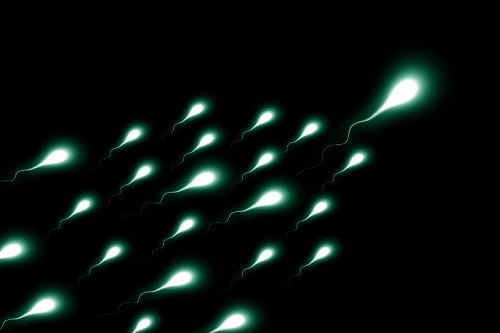Reference article: Umehara T, Tsujita N, Shimada M (2019) Activation of Toll-like receptor 7/8 encoded by the X chromosome alters sperm motility and provides a novel simple technology for sexing sperm. PLoS Biol 17(8): e3000398 LINK: http://journals.plos.org/plosbiology/article?id=10.1371/journal.pbio.3000398
Original text by PLOS Biology
Differential gene activity by the two sex chromosomes allows X-bearing sperm to be slowed down

Both X sperm and Y sperm swim to oocyte for fertilization. The probability to bind and penetrate to oocyte is same; however, under the specific condition, the ration of X sperm and Y sperm to reach to oocyte is changed. Credit: Gerd Altmann from Pixabay
A simple, reversible chemical treatment can segregate X-bearing sperm from Y-bearing sperm, allowing dramatic alteration of the normal 50/50 male/female offspring ratio, according to a new study by Masayuki Shimada and colleagues at Hiroshima University, published on August 13 in the open-access journal PLOS Biology. The study was performed in mice, but the technique is likely to be widely applicable to other mammals as well.
Most cells from male mammals contain both an X and a Y chromosome, but during sperm development (spermatogenesis), the X and Y chromosomes are segregated into different cells so that an individual sperm will carry either one or the other, with an X chromosome giving rise to daughters and a Y chromosome to sons.
Unlike the Y chromosome, which carries very few genes, the X chromosome carries many, some of which remain active in the maturing sperm. This difference in gene expression between X- and Y-bearing sperm provides a theoretical basis for distinguishing the two.
The authors found that almost 500 genes are active only in X-bearing sperm, of which 18 genes encoded receptors; because of their functions to response to ligand stimuli this made them good candidates for manipulating the sperm. They focused on a pair of receptors called Toll-like receptor 7 and 8 (TLR7/8) and found that a chemical that bound to the receptors slowed sperm motility without impairing either sperm fertilization ability or viability. They showed the effect was due to impaired energy production within the sperm and could be reversed by removal of the chemical from the medium.
Treatment of mouse sperm with this X-retarding chemical, followed by in vitro fertilization with the fastest swimmers, led to litters that were 90% male. When the slower swimmers were used instead, the litters were 81% female.
There are other procedures that can be used to separate X and Y sperm, but they are cumbersome, expensive, and risk damaging the DNA of the sperm. The procedure developed by these authors has the potential to greatly simplify sex selection for either in vitro fertilization (in which sperm and egg join in a lab dish) or artificial insemination (in which sperm are implanted into the female reproductive tract). Such techniques are widely used in the agricultural animal breeding field, as well as in human assisted reproduction.
“The differential expression of receptor genes by the two sex chromosomes provides the basis for a novel and potentially highly useful method for separating X and Y sperm and we have already succeeded the selectively production of male or female in cattle and pig by this method,” Shimada said.
“Nonetheless, use of this method in human reproductive technology is speculative at the moment, and involves significant ethical issues unaffected by the utility of this new technique.”
Funding: This work was supported in part by Livestock Promotional Funds of Japan Racing Association (JRA) and by Hiroshima Cryopreservation Service Co. (to MS).
- Profile of Professor Masayuki Shimada
- Find more Hiroshima University research news on our Facebook page.
Professor Masayuki Shimada
Graduate School of Integrated Sciences for Life, Hiroshima University
E-mail: mashimad*hiroshima-u.ac.jp (Please replace * with @)

 Home
Home














